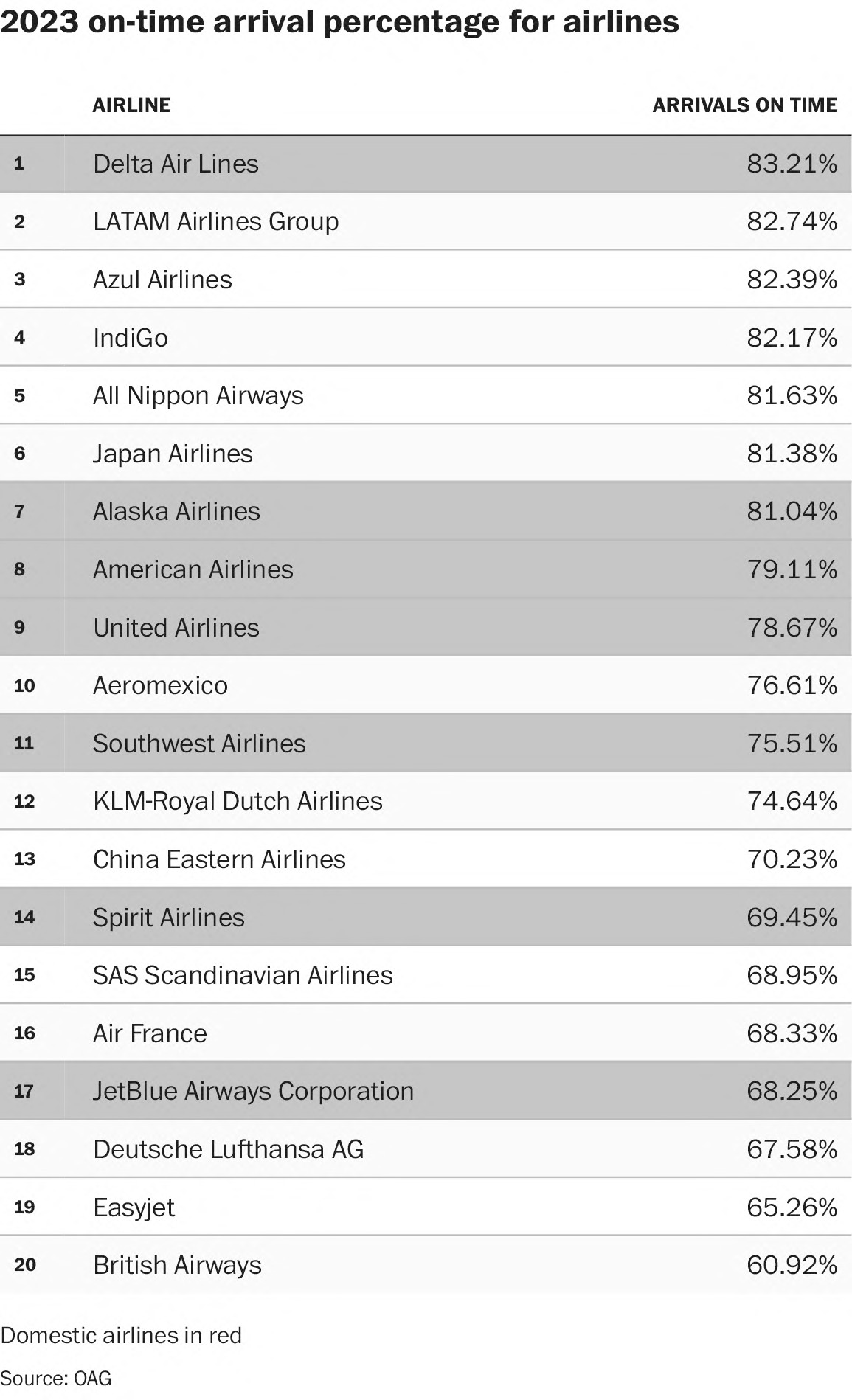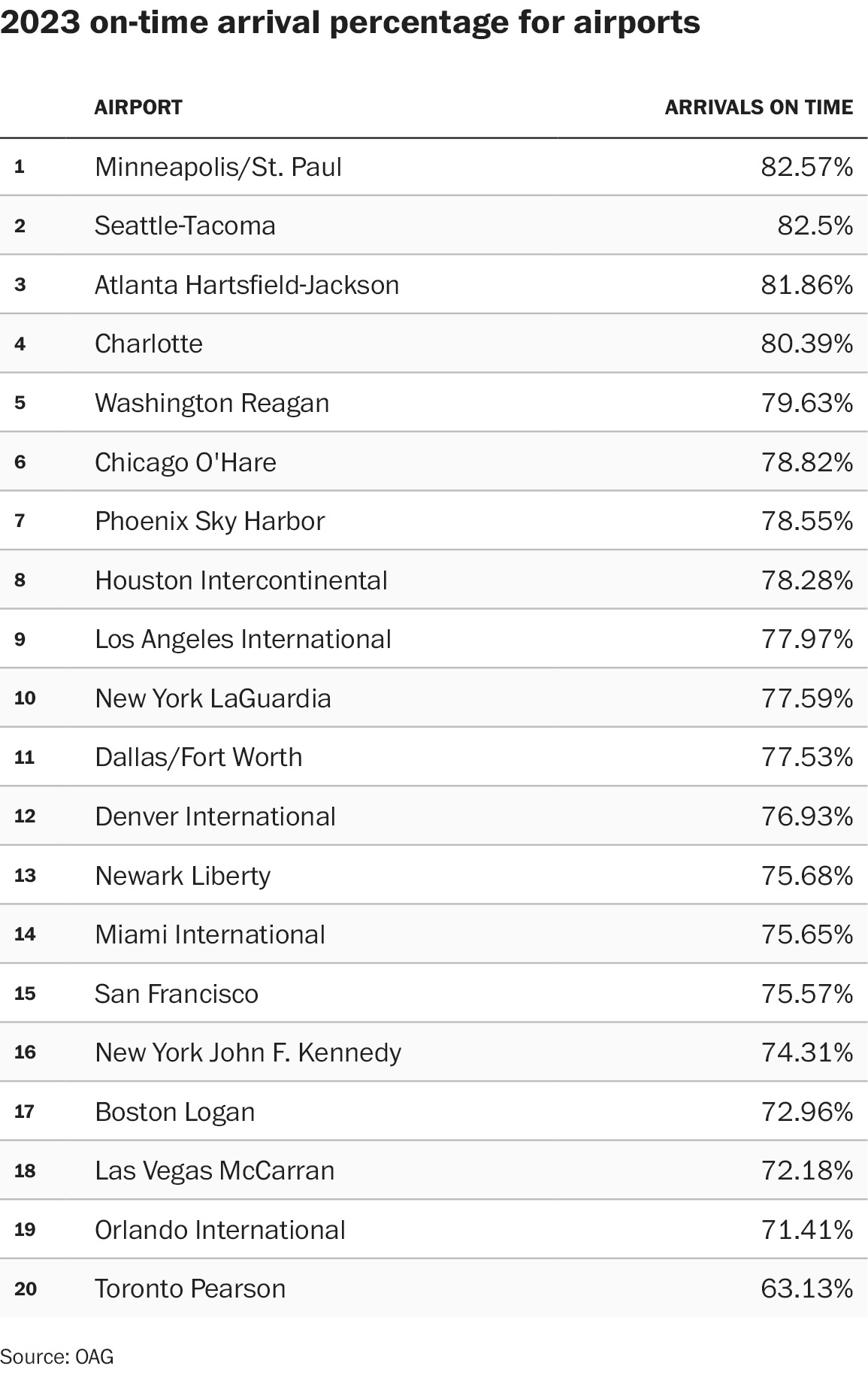Subscriber Benefit
As a subscriber you can listen to articles at work, in the car, or while you work out. Subscribe NowIf you flew Delta Air Lines last year, there’s a good chance your flight was on time.
The carrier was the most punctual in the United States, according to new rankings from airline schedule data firm OAG. By this measure, 83.2% of Delta’s 1.6 million global flights arrived without a hitch.
And the airport with the most punctual flights? Few will be surprised that it was Minneapolis-St. Paul, a large Delta hub, where about 82.6% of flights left on schedule, despite its snow-packed location.
 An on-time flight is defined as one that arrives within 15 minutes of its scheduled arrival. Airlines supplied OAG with the data for its rankings, which include only carriers that provide information on at least 80% of their flights.
An on-time flight is defined as one that arrives within 15 minutes of its scheduled arrival. Airlines supplied OAG with the data for its rankings, which include only carriers that provide information on at least 80% of their flights.
The on-time performance came during a challenging year for airlines. It kicked off with the outage of a key Federal Aviation Administration notification system in January that prompted the first nationwide halt in air traffic since the Sept. 11, 2001, attacks. A national air traffic controller shortage forced airlines to prune schedules. And severe weather disrupted flights in New York and elsewhere over the summer.
“Strong on-time performance results from Delta, American, United, and others point to a collective effort by the industry to overcome challenges,” OAG’s chief analyst, John Grant, said in a news release. He cited the operational issues airlines faced, as well as industry-wide maintenance and supply chain challenges.
After Delta, Alaska Airlines was the second most punctual among domestic carriers—and seventh worldwide—with 81% of flights arriving on time, OAG’s data shows. American Airlines flights were 79% on time, United Airlines nearly 79% and Southwest nearly 76%. Spirit Airlines and JetBlue Airways rounded out the list of U.S. airlines in OAG’s rankings, with 69.5% and 68.3%of flights, respectively, arriving on schedule.
Most U.S. airlines were more punctual last year than in 2022. Delta, Alaska and American improved by roughly two percentage points, while United performed about the same. Even laggard JetBlue improved by about four points.
Delta executives throughout the year praised the airline’s staff for its reliable operation. “Our people consistently deliver operational excellence with the relentless focus on raising the bar at every stage of the travel journey,” CEO Ed Bastian said earlier this month. The secret to on-time flights, however, runs deeper.
 “The way you keep an airline on time is you schedule flights for a realistic amount of time, and have enough time on the ground between flights,” said Atmosphere Research Group travel analyst Henry Harteveldt. Delta, he continued, does both, scheduling flights for an appropriate duration, then providing enough time on the ground for staff to fully prepare planes for the next flight.
“The way you keep an airline on time is you schedule flights for a realistic amount of time, and have enough time on the ground between flights,” said Atmosphere Research Group travel analyst Henry Harteveldt. Delta, he continued, does both, scheduling flights for an appropriate duration, then providing enough time on the ground for staff to fully prepare planes for the next flight.
It helps that Delta’s busiest airports are Atlanta, Detroit and Minneapolis-St. Paul, none of which faces the same level of congestion in the air or on the tarmac that plagues many airports in the northeast and Florida.
Most flight delays in 2023 were airlines’ fault, according to the Transportation Department—due to aircraft maintenance or a late crew, for example.
When a delay is the airline’s fault, it is responsible for accommodating travelers on another flight and, in some cases, offering meal or hotel vouchers, or even a refund. The DOT has a dashboard of travelers’ rights when airlines are responsible for the delay or cancellation.
But the shortage of air traffic controllers, coupled with severe weather last summer, played a significant role in punctuality in 2023.
In March, the FAA said national air traffic controller staffing was at 81% of target levels and, in the center that manages flights in and around New York City, at only 54%. As a result, it allowed airlines to cut flights by 10% at New York’s three main airports—John F. Kennedy International, LaGuardia and Newark Liberty—over the summer to minimize disruptions. Still, JetBlue faced 68 days of “significant operational disruption” in New York during the three months ending in September, airline President Joanna Geraghty said in an earnings call.
“Far worse September weather” and “unprecedented [air traffic control] restrictions” caused the disruptions, Geraghty said. Add to that the fact that a greater percentage of JetBlue’s flights than any other airline is in congested New York airspace, and the delays multiplied.
“If you are always driving on a congested highway, you are more prone to adverse conditions that might affect performance,” said Ahmed Abdelghany, associate dean in the David B. O’Maley College of Business at Embry-Riddle Aeronautical University in Florida. This means airlines flying in congested areas—like JetBlue in the northeast—are more susceptible to flight delays and cancellations.
Airport on-time rankings are largely outside of their direct control. Ones with plenty of capacity—runways, gates and other facilities to accommodate their full allotment of scheduled flights—are less likely to see delays than congested airports that operate near or at capacity, Abdelghany said.
Lack of congestion in the skies above is also important. For example, in New York, the FAA has very specific—and separate—routes for flights into and out of JFK, LaGuardia and Newark. If a direction is blocked by storms, one airport can see flight delays and cancellations spike while another continues to operate smoothly.
Then there is the simple indicator that if an airport’s main airline is reliable, that airport probably is, too. The three airports with the most on-time departures in the United States last year—Minneapolis-St. Paul, Seattle-Tacoma and Atlanta—are all Delta hubs. Charlotte and Reagan National Airport rounded out the Top 5.
Please enable JavaScript to view this content.

My last Delta flight was Portland to Minneapolis to Fort Wayne. As booked, I had 2 hours to make the Minneapolis connection. Delta left Portland nearly 2 hours late, landed in Minneapolis and sat on the tarmac 20-30 minutes waiting for a gate. I had 5 minutes until the connector was to leave. After a scooter ride, I had to run up a few stairs and then a quarter mile, and got to watch Cpt Johnny Rocket sit 20′ from the gate finishing his paper work. There were no more flights that evening. At 8am I was at the airport trying to get a flight and the attendant told me because I used a vendor, Booking.com, he could not put me on an earlier flight and I had to wait until the evening flight. My luggage was in Fort Wayne 10 hours before I got there. It will be hard to convince me that Delta is #1 in promptness. I had 3 legs on my last flight with United, and it was on time on all three.
I have had a lot of different jobs and none would have described arriving on time 83.2% of the time as “punctual”. (Don’t know how start times work at IBJ,)